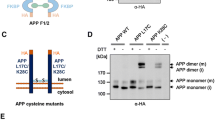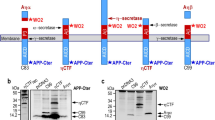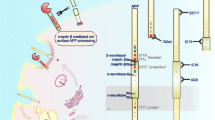Abstract
The neurotoxic Abeta peptide is derived by proteolytic processing from the Alzheimer’s amyloid precursor protein (APP), whose short cytoplasmic domain contains several phosphorylatable amino acids. The latter can be phosphorylated ‘in vitro’ and ‘in vivo,’ and in some cases phosphorylation appears to be associated with the disease condition. Using APP-GFP fusion proteins to monitor APP processing, the role of Tyr687 was addressed by mimicking its constitutive phosphorylation (Y687E) and dephosphorylation (Y687F). Contrasting effects on subcellular APP distribution were observed. Y687E-APP-GFP was targeted to the membrane but could not be detected in transferrin containing vesicular structures, and exhibited a concomitant and dramatic decrease in Abeta production. In contrast, Y687F-APP-GFP was endocytosed similarly to wild type APP, but was relatively favoured for beta-secretase cleavage. Overall, Tyr687 appears to be a critical residue determining APP targeting and processing via different pathways, including endocytosis and retrograde transport. Significantly, from a disease perspective, mimicking Tyr687 phosphorylation resulted in a hitherto undescribed inhibition of Abeta production. Our results provide novel insights into the role of direct APP phosphorylation on APP targeting, processing and Abeta production.
Similar content being viewed by others
References
Ando, K., Iijima, K. I., Elliot, J. I., Kirino, Y., & Suzuki, T. (2001). Phosphorylation-dependent regulation of the interaction of amyloid precursor protein with Fe65 affects the production of beta-amyloid. Journal of Biological Chemistry, 276, 40353–40361.
Benmerah, A., Lamaze, C., Begue, B., Schmid, S. L., Dautry-Varsat, A., & Cerf-Bensussan, N. (1998). AP-2/Eps15 interaction is required for receptor-mediated endocytosis. Journal of Cell Biology, 140, 1055–1062.
Bennett, B. D., Babu-Khan, S., Loeloff, R., Louis, J. C., Curran, E., Citron, M., et al. (2000). Expression analysis of BACE2 in brain and peripheral tissues. Journal of Biological Chemistry, 275, 20647–20651.
Borg, J. P., Lopez-Figueroa, M. O., de Taddeo-Borg, M., Kroon, D. E., Turner, R. S., Watson, S. J., et al. (1999). Molecular analysis of the X11-mLin-2/CASK complex in brain. Journal of Neuroscience, 19, 1307–1316.
Bressler, S. L., Gray, M. D., Sopher, B. L., Hu, Q., Hearn, M. G., Pham, D. G., et al. (1996). cDNA cloning and chromosome mapping of the human Fe65 gene: Interaction of the conserved cytoplasmic domains of the human beta-amyloid precursor protein and its homologues with the mouse Fe65 protein. Human Molecular Genetics, 5, 1589–1598.
Chen, W. J., Goldstein, J. L. & Brown, M. S. (1990). NPXY, a sequence often found in cytoplasmic tails, is required for coated pit-mediated internalization of the low-density lipoprotein receptor. Journal of Biological Chemistry, 265, 3116–3123.
Capell, A., Beher, D., Prokop, S., Steiner, H., Kaether, C., Shearman, M. S., et al. (2005). Gamma-secretase complex assembly within the early secretory pathway. Journal of Biological Chemistry, 280, 6471–6478.
da Cruz e Silva, E. F., & da Cruz e Silva, O. A. (2003). Protein phosphorylation and APP metabolism. Neurochemical Research, 28, 1553–1561.
da Cruz e Silva, O. A., Fardilha, M., Henriques, A. G., Rebelo, S., Vieira, S., & da Cruz e Silva, E. F. (2004a). Signal transduction therapeutics: Relevance for Alzheimer’s disease. Journal of Molecular Neuroscience, 23, 123–142.
da Cruz e Silva, O. A., Vieira, S. I., Rebelo, S., & da Cruz e Silva, E. F. (2004b). A model system to study intracellular trafficking and processing of the Alzheimer’s Amyloid Precursor Protein. Neurodegenerative Diseases, 1, 196–204.
Esler, W. P., Kimberly, W. T., Ostaszewski, B. L., Ye, W., Diehl, T. S., Selkoe, D. J., et al. (2002). Activity-dependent isolation of the presenilin-gamma-secretase complex reveals nicastrin and a gamma substrate. Proceedings of the National Academy of Sciences of the United States of America, 99, 2720–2725.
Esselmann, H., Maler, J. M., Kunz, N., Otto, M., Paul, S., Lewczuk, P., et al. (2004). Lithium decreases secretion of Aβ1-42 and C-truncated species Aβ1-37/38/39/40 in chicken telencephalic cultures but specifically increases intracellular Aβ1-38. Neurodegenerative Diseases, 1, 236–241.
Gandy, S., & Greengard, P. (1994). Regulated cleavage of the Alzheimer amyloid precursor protein: Molecular and cellular basis. Biochimie, 76, 300–303.
Homayouni, R., Rice, D. S., Sheldon, M., & Curran, T. (1999). Disabled-1 binds to the cytoplasmic domain of amyloid precursor-like protein 1. Journal of Neuroscience, 19, 7507–7515.
Kinoshita, A., Whelan, C. M., Berezovska, O., & Hyman, B. T. (2002). The gamma secretase-generated carboxyl-terminal domain of the amyloid precursor protein induces apoptosis via Tip60 in H4 cells. Journal of Biological Chemistry, 277, 28530–28536.
Koo, E. H., & Squazzo, S. L. (1994). Evidence that production and release of amyloid beta-protein involves the endocytic pathway. Journal of Biological Chemistry, 269, 17386–17389.
Kroenke, C. D., Ziemnicka-Kotula, D., Xu, J., Kotula, L., & Palmer, A. G. (1997). Solution conformations of a peptide containing the cytoplasmic domain sequence of the beta amyloid precursor protein. Biochemistry, 36, 8145–8152.
Lai, A., Sisodia, S. S., & Trowbridge, I. S. (1995). Characterization of sorting signals in the beta-amyloid precursor protein cytoplasmic domain. Journal of Biological Chemistry, 270, 3565–3573.
Lee, S. F., Shah, S., Li, H., Yu, C., Han, W., & Yu, G. (2000). Mammalian APH-1 interacts with presenilin and nicastrin and is required for intramembrane proteolysis of amyloid-beta precursor protein and Notch. Journal of Biological Chemistry, 277, 45013–45019.
Lee, M. S., Kao, S. C., Lemere, C. A., Xia, W., Tseng, H. C., Zhou, Y., et al. (2003). APP processing is regulated by cytoplasmic phosphorylation. Journal of Cell Biology, 163, 83–95.
Li, Y. M., Lai, M. T., Xu, M., Huang, Q., DiMuzio-Mower, J., Sardana, M. K., et al. (2000a). Presenilin 1 is linked with gamma-secretase activity in the detergent solubilized state. Proceedings of the National Academy of Sciences of the United States of America, 97, 6138–6143.
Li, Y. M., Xu, M., Lai, M. T., Huang, Q., Castro, J. L., DiMuzio-Mower, J., et al. (2000b). Photoactivated gamma-secretase inhibitors directed to the active site covalently label presenilin 1. Nature, 405, 689–694.
McLoughlin, D. M., & Miller, C. C. (1999). The intracellular cytoplasmic domain of the Alzheimer’s disease amyloid precursor protein interacts with phosphotyrosine-binding domain proteins in the yeast two-hybrid system. FEBS Letters, 397, 197–200.
Nakaya, T., & Suzuki, T. (2006). Role of APP phosphorylation in FE65-dependent gene transactivation mediated by AICD. Genes Cells, 11, 633–645.
Nixon, R. A., Mathews, P. M., & Cataldo, A. M. (2001). The neuronal endosomal-lysosomal system in Alzheimer’s disease. Journal of Alzheimer’s Disease, 3, 97–107.
Oishi, M., Nairn, A. C., Czernik, A. J., Lim, G. S., Isohara, T., Gandy, et al. (1997). The cytoplasmic domain of Alzheimer’s amyloid precursor protein is phosphorylated at Thr654, Ser655, and Thr668 in adult rat brain and cultured cells. Molecular Medicine, 3, 111–123.
Perez, R. G., Soriano, S., Hayes, J. D., Ostaszewski, B., Xia, W., Selkoe, D. J., et al. (1999). Mutagenesis identifies new signals for beta-amyloid precursor protein endocytosis, turnover, and the generation of secreted fragments, including Abeta42. Journal of Biological Chemistry, 274, 18851–18856.
Ramelot, T. A., Gentile, L. N., & Nicholson, L. K. (2000). Transient structure of the amyloid precursor protein cytoplasmic tail indicates preordering of structure for binding to cytosolic factors. Biochemistry, 39, 2714–2725.
Rebelo, S., Henriques, A. G., da Cruz E Silva, E. F., & da Cruz E Silva, A. O. B. (2004). Effect of cell density on intracellular levels of the Alzheimer’s amyloid precursor protein. Journal of Neuroscience Research, 76, 406–414.
Sabo, S. L., Ikin, A. F., Buxbaum, J. D., & Greengard, P. (2001). The Alzheimer amyloid precursor protein (APP) and FE65, an APP-binding protein, regulate cell movement. Journal of Cell Biology, 153, 1403–1414.
Steiner, H., Winkler, E., Edbauer, D., Prokop, S., Basset, G., Yamasaki, A., et al. (2002). PEN-2 is an integral component of the gamma-secretase complex required for coordinated expression of presenilin and nicastrin. Journal of Biological Chemistry, 277, 39062–39065J.
Tarr, P. E., Contursi, C., Roncarati, R., Noviello, C., Ghersi, E., Scheinfeld, M. H., et al. (2002). Evidence for a role of the nerve growth factor receptor TrkA in tyrosine phosphorylation and processing of beta-APP. Biochemical and Biophysical Research Communications, 295, 324–329.
Vassar, R., Bennett, B. D., Babu-Khan, S., Kahn, S., Mendiaz, E. A., Denis, P., et al. (1999). Beta-secretase cleavage of Alzheimer’s amyloid precursor protein by the transmembrane aspartic protease BACE. Science, 286, 735–741.
Verdile, G., Gandy, S. E., Martins, R. N. (2006). The Role of Presenilin and its Interacting Proteins in the Biogenesis of Alzheimer’s Beta Amyloid. Neurochemical Research 2006 Aug 31, in press.
Wahle, T., Prager, K., Raffler, N., Haass, C., Famulok, M., & Walter, J. (2005). GGA proteins regulate retrograde transport of BACE1 from endosomes to the trans-Golgi network. Molecular and Cellular Biochemistry, 29, 453–461.
Wiltfang, J., Esselmann, H., Cupers, P., Neumann, M., Kretzschmar, H., Beyermann, M., et al. (2001). Elevation of beta-amyloid peptide 2–42 in sporadic and familial Alzheimer’s disease and its generation in PS1 knockout cells. Journal of Biological Chemistry, 276, 42645–42657.
Wiltfang, J., Esselmann, H., Bibl, M., Smirnov, A., Otto, M., Paul, S., et al. (2002). Highly conserved and disease-specific patterns of carboxyterminally truncated Abeta peptides 1–37/38/39 in addition to 1–40/42 in Alzheimer’s disease and in patients with chronic neuroinflammation. Journal of Neurochemistry, 81, 481–496.
Yan, R., Munzner, J. B., Shuck, M. E., & Bienkowski, M. J. (2001). BACE2 functions as an alternative alpha-secretase in cells. Journal of Biological Chemistry, 276, 34019–34027.
Zambrano, N., Bruni, P., Minopoli, G., Mosca, R., Molino, D., Russo, C., et al. (2001). The beta-amyloid precursor protein APP is tyrosine-phosphorylated in cells expressing a constitutively active form of the Abl protoncogene. Journal of Biological Chemistry, 276, 19787–19792.
Author information
Authors and Affiliations
Corresponding author
Rights and permissions
About this article
Cite this article
Rebelo, S., Vieira, S.I., da Cruz e Silva, O.A.B. et al. Tyr687 dependent APP endocytosis and abeta production. J Mol Neurosci 32, 1–8 (2007). https://doi.org/10.1007/s12031-007-0001-z
Received:
Accepted:
Published:
Issue Date:
DOI: https://doi.org/10.1007/s12031-007-0001-z




